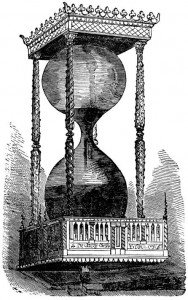Rio De Janeiro’s 2016 Olympic Games
Part II
Becky Kospanova
This year, thousands of people watched the Summer Olympic Games being held in London, Great Britain – one of the most renowned cities of the world. However, in four years, the Olympiad of 2016 will come to Rio de Janeiro, Brazil – a spectacular city with rich history, fascinating culture, and beautiful people. It will be the first time a South American city will host such an event, which understandably brings a lot of pride and excitement to the people of Rio and Brazil.
How did the election process occur? In 2009, members of the International Olympic Committee (IOC) met in Denmark to discuss the candidate cities and, after three rounds of voting, selected Rio to hold the 2016 Games. Initially, seven cities (Chicago, Madrid, Tokyo, Prague, Baku, Doha, and Rio) were proposed by their National Olympic Committees to hold the Olympics. After the voting in 2008, the IOC chose four candidate cities – Chicago, Tokyo, Madrid, and Rio- to be considered as a future host of the Games. After three rounds of voting in 2009, Rio received 66 votes as opposed to 32 votes for Madrid and was given an honor to hold the Olympiad. The judges were very impressed by the proposed plans for building an excellent Olympic village and sporting venues located at four zones and connected by a highway ring, which will allow the athletes to arrive at their destinations quickly.
Undoubtedly, athletes along with spectators and fans will be thrilled to have the Games in Rio – one of the most beautiful cities in the world. When one thinks about Rio, the first things which come to mind are its sandy beaches, festive carnivals, the enormous statue of Jesus the Redeemer on top of Corcovado mountain which overlooks the whole city and, of course, its beautiful and friendly people. However, Rio, which was founded in 1565 by Portuguese, boasts rich history and culture as well. Since late 17th century, Rio became an administrative capital of Portuguese America; and in 1808, the Portuguese Royal family along with other nobility, escaping Europe from Napoleon, moved its capital to Rio. Thus, Rio became the only European capital located outside Europe! In 1822, Brazil obtained its independence from Portugal, but Rio stayed a capital until 1960, when a newly built city of Brasilia became a new capital of the country.
Rio’s history and architecture were influenced by Portuguese, French, English, and its native cultures. There are many spectacular churches, museums, palaces, universities, and old homes which will certainly impress everybody. In fact, Rio is the most visited city in South America with almost 2.5 million tourists arriving annually. There are many historical landmarks in Rio such as National Library, the seventh largest library in the world, National Museum of Fine Arts, National Museum of Natural Science, Botanical Garden, and the Imperial Square. On July 1, 2012, UNESCO granted Rio de Janeiro a title of World Heritage Site in the category of Cultural Landscapes.
All these factors will indisputably greatly enhance the experience of Olympic Games of 2016 for all involved!






 chatting with friends and suddenly you realize that you heard this conversation before. You know exactly where the discussion is leading too and what will be said. Or you visit a place for the first time and that feeling comes over you that you have been there before. It’s not surprising if you are also one of the 70% of the people who claim to have gone through what some would considered a bizarre experience. The reasons and why this happens is a mystery that still continues to go through numerous theories and studies by and between several groups of people. Psychoanalysts explain this as a method of fantasy fulfillment while Psychiatrists describe it as a short circuit occurring in the brain when an event makes its way into the memory, just a split second before you become mentally aware of the event.
chatting with friends and suddenly you realize that you heard this conversation before. You know exactly where the discussion is leading too and what will be said. Or you visit a place for the first time and that feeling comes over you that you have been there before. It’s not surprising if you are also one of the 70% of the people who claim to have gone through what some would considered a bizarre experience. The reasons and why this happens is a mystery that still continues to go through numerous theories and studies by and between several groups of people. Psychoanalysts explain this as a method of fantasy fulfillment while Psychiatrists describe it as a short circuit occurring in the brain when an event makes its way into the memory, just a split second before you become mentally aware of the event.

 Part 1
Part 1 For the first 13 Olympiads, only races were held; but over the years, other sports such as pentathlon (which included sprint, wrestling, javelin, jumping, and discus) and pancration (combination of wrestling and boxing) were added. At first, only Greeks were allowed to compete but eventually, athletes from Roman Empire were allowed to participate as well. After the Roman victory over Greece in 100 BC, the initial emphasis on personal honor, physical strength, and achievement gave way to glory-seeking and Olympic spirit deteriorated. In 394 AD, the Christian Roman Emperor Theodosius the First abolished the Olympic Games because he believed that they were the manifestations of pagan beliefs.
For the first 13 Olympiads, only races were held; but over the years, other sports such as pentathlon (which included sprint, wrestling, javelin, jumping, and discus) and pancration (combination of wrestling and boxing) were added. At first, only Greeks were allowed to compete but eventually, athletes from Roman Empire were allowed to participate as well. After the Roman victory over Greece in 100 BC, the initial emphasis on personal honor, physical strength, and achievement gave way to glory-seeking and Olympic spirit deteriorated. In 394 AD, the Christian Roman Emperor Theodosius the First abolished the Olympic Games because he believed that they were the manifestations of pagan beliefs.
 also a great opportunity. Our days are typically crammed with tasks and technology. How often do you get a few minutes to yourself (not counting watching TV, being on the computer or listening to your iPod)? Just a few minutes to actually sit in silence and gather your thoughts can help. If that doesn’t sound appealing, use the time to call and catch up with a loved one or to listen to calming music or a new audio book. The key is to accept that at this very moment, there’s nothing you can do about all the congestion. Many of us sprint through our days. Traffic – though upsetting — gives us the opportunity to slow down and do something more pleasant than stew in our seats.
also a great opportunity. Our days are typically crammed with tasks and technology. How often do you get a few minutes to yourself (not counting watching TV, being on the computer or listening to your iPod)? Just a few minutes to actually sit in silence and gather your thoughts can help. If that doesn’t sound appealing, use the time to call and catch up with a loved one or to listen to calming music or a new audio book. The key is to accept that at this very moment, there’s nothing you can do about all the congestion. Many of us sprint through our days. Traffic – though upsetting — gives us the opportunity to slow down and do something more pleasant than stew in our seats. Another tip: As you feel the rage for a slow employee rise, try to muster up some empathy. No doubt at some point in your life you were slow at a new job (or in another situation). Rather than getting angry put you in their shoes. Anger ignites impatience. But empathy can ease irritation, and help patience prosper.
Another tip: As you feel the rage for a slow employee rise, try to muster up some empathy. No doubt at some point in your life you were slow at a new job (or in another situation). Rather than getting angry put you in their shoes. Anger ignites impatience. But empathy can ease irritation, and help patience prosper. Seek patience
Seek patience The development of technology for the last few decades is truly impressive. In particular, cell phones, which were first introduced in the 1980s and has made a spectacular jump from simple devices intended for just talking to multi-purpose gadgets. Nowadays, smart phones can be used by their owners as computers to surf the web, video and photo cameras, music players, calendars, gaming systems, GPS navigators, and much more. Of course, all these additions while very convenient may come with a price.
The development of technology for the last few decades is truly impressive. In particular, cell phones, which were first introduced in the 1980s and has made a spectacular jump from simple devices intended for just talking to multi-purpose gadgets. Nowadays, smart phones can be used by their owners as computers to surf the web, video and photo cameras, music players, calendars, gaming systems, GPS navigators, and much more. Of course, all these additions while very convenient may come with a price. provide.
provide.
 Someone please tell me what the Hell’s is wrong with the people that run this country, Republicans and Democrats alike. When the Democrats had control of the House and Senate; they were not able to accomplish much as they were to busy in fighting amongst themselves and letting the people who really needed their help down.
Someone please tell me what the Hell’s is wrong with the people that run this country, Republicans and Democrats alike. When the Democrats had control of the House and Senate; they were not able to accomplish much as they were to busy in fighting amongst themselves and letting the people who really needed their help down. He ordered his eldest son, his nephew, and his second wife put to death. He tortured, murdered and imprisoned anyone, including cousins and former friends, known or suspected of being political rivals. He issued an edict on religious freedom for all in his dominions yet dismantled temples and looted their treasuries. He proclaimed himself a follower of the Prince of Peace, yet his path to undisputed power was littered with battles, great and small.
He ordered his eldest son, his nephew, and his second wife put to death. He tortured, murdered and imprisoned anyone, including cousins and former friends, known or suspected of being political rivals. He issued an edict on religious freedom for all in his dominions yet dismantled temples and looted their treasuries. He proclaimed himself a follower of the Prince of Peace, yet his path to undisputed power was littered with battles, great and small. authorities had launched a systematic assault to suppress Christianity. It was a time referred to by members of that community as the “Great Persecution.”
authorities had launched a systematic assault to suppress Christianity. It was a time referred to by members of that community as the “Great Persecution.” Summer and Beach- What to Wear and How to Protect Yourself from the Sun!
Summer and Beach- What to Wear and How to Protect Yourself from the Sun! and oversized sunglasses are in. Also, the color of your sunglasses can vary widely from pink, yellow, and blue to classic grey, black, and brown. Gradient lenses are also popular in 2012. Also, to better protect yourself from relentless sun, bring a brimmed hat or at least a cap. Floppy wide-brimmed hats seem to be all the rage this season. For leisurely strolls along the beach, bring along a cover-up such as chiffon skirt, sarong, or wrap; and for a man, light t-shirt always works well. You can also improve your beach look by playing with your footwear. Instead of plain and boring flip-flops, choose sandals decorated with beads, rhinestones, or appliqués for a true fashion statement.
and oversized sunglasses are in. Also, the color of your sunglasses can vary widely from pink, yellow, and blue to classic grey, black, and brown. Gradient lenses are also popular in 2012. Also, to better protect yourself from relentless sun, bring a brimmed hat or at least a cap. Floppy wide-brimmed hats seem to be all the rage this season. For leisurely strolls along the beach, bring along a cover-up such as chiffon skirt, sarong, or wrap; and for a man, light t-shirt always works well. You can also improve your beach look by playing with your footwear. Instead of plain and boring flip-flops, choose sandals decorated with beads, rhinestones, or appliqués for a true fashion statement. Perhaps Leonardo Da Vinci said it best, “Once you have flown, you will walk the earth with your eyes turned skyward, for there you have been, and there you long to return.” Certainly that lyrical sentiment was true for the two men who celebrate a record setting, 25th anniversary this July.
Perhaps Leonardo Da Vinci said it best, “Once you have flown, you will walk the earth with your eyes turned skyward, for there you have been, and there you long to return.” Certainly that lyrical sentiment was true for the two men who celebrate a record setting, 25th anniversary this July.
 Due to weather conditions, the landing site had been altered from the British Isles to the Ireland coast. Technically, they touched down briefly on the targeted beach but a mechanism that releases the balloon from the capsule failed to work. Soon, they were on a bumpy, bouncing ride across the channel. Rough, contentious seas seeped into the capsule. Though there was some discussion on coaxing the limping conveyance to shore, both men concluded it was wiser to hazard a helicopter rescue from the water after a 60-foot leap off the capsule roof. Despite their soggy touchdown, the trip was an undeniable success.
Due to weather conditions, the landing site had been altered from the British Isles to the Ireland coast. Technically, they touched down briefly on the targeted beach but a mechanism that releases the balloon from the capsule failed to work. Soon, they were on a bumpy, bouncing ride across the channel. Rough, contentious seas seeped into the capsule. Though there was some discussion on coaxing the limping conveyance to shore, both men concluded it was wiser to hazard a helicopter rescue from the water after a 60-foot leap off the capsule roof. Despite their soggy touchdown, the trip was an undeniable success.
 The 4th of July is probably one of the most well-known and beloved holidays in the United States of America. Everybody looks forward to firing up some barbecue, inviting friends and family to share their meal, watch the fireworks, and enjoy all things American. However, there is considerably more behind this holiday than the usual things, which came to be associated with it. While most people connect the 4th of July with such words as Concord, Lexington, Bunker Hill, and the “British Are Coming,”- there is more to the history of the Independence War. Most people associate the white Protestants as a major force behind the Independence War. However, it was not exactly the case. There were other segments of American population, which provided invaluable input toward the ultimate goal of achieving independence from the British Empire.
The 4th of July is probably one of the most well-known and beloved holidays in the United States of America. Everybody looks forward to firing up some barbecue, inviting friends and family to share their meal, watch the fireworks, and enjoy all things American. However, there is considerably more behind this holiday than the usual things, which came to be associated with it. While most people connect the 4th of July with such words as Concord, Lexington, Bunker Hill, and the “British Are Coming,”- there is more to the history of the Independence War. Most people associate the white Protestants as a major force behind the Independence War. However, it was not exactly the case. There were other segments of American population, which provided invaluable input toward the ultimate goal of achieving independence from the British Empire. Federal government fails when it comes to enforcing United States race classification laws (Changing the majority)
Federal government fails when it comes to enforcing United States race classification laws (Changing the majority) reclassified; they will still be in the majority and therefore need to catch up on their African history by reviewing books like, Dr. Chancellor James Williams an African American sociologist, historian and writer and the author of “The Destruction of Black Civilization” (1971).
reclassified; they will still be in the majority and therefore need to catch up on their African history by reviewing books like, Dr. Chancellor James Williams an African American sociologist, historian and writer and the author of “The Destruction of Black Civilization” (1971). ll, music industry is thriving. The number of albums and songs released each year is growing and new artists appear seemingly on a daily basis. Consequently, musical environment of 2012 is substantially different from that of 1992, at least quantitatively if not qualitatively (in opinions of many people, our two biggest pop stars of today, Lady Gaga and Adele, are somewhat reminiscent of Madonna and Mariah Carey). So, it seems to be good news that all technological innovations led to the positive development of music industry. However, it is not exactly so. While music industry is in good shape, record industry is negatively affected by the ease with which people can access music nowadays.
ll, music industry is thriving. The number of albums and songs released each year is growing and new artists appear seemingly on a daily basis. Consequently, musical environment of 2012 is substantially different from that of 1992, at least quantitatively if not qualitatively (in opinions of many people, our two biggest pop stars of today, Lady Gaga and Adele, are somewhat reminiscent of Madonna and Mariah Carey). So, it seems to be good news that all technological innovations led to the positive development of music industry. However, it is not exactly so. While music industry is in good shape, record industry is negatively affected by the ease with which people can access music nowadays.
 Time and People: How and When We Started Keeping Time
Time and People: How and When We Started Keeping Time
 Ask any adult what they think about riding a motorcycle and you’re likely to get one of two answers—very cool or totally nuts. For those folks that are dedicated “bikers,” no amount of scary stats on accidents, brain injuries, or deaths will convince them to give up their Harleys or Hondas; others are convinced that even a parked motorcycle is lethal. This is a machine that inspires intense feelings, good, bad, and ugly.Today, more people than ever before are riding motorcycles, some estimates put the number at about
Ask any adult what they think about riding a motorcycle and you’re likely to get one of two answers—very cool or totally nuts. For those folks that are dedicated “bikers,” no amount of scary stats on accidents, brain injuries, or deaths will convince them to give up their Harleys or Hondas; others are convinced that even a parked motorcycle is lethal. This is a machine that inspires intense feelings, good, bad, and ugly.Today, more people than ever before are riding motorcycles, some estimates put the number at about  Testosterone, it’s a natural substance with a colorful history and now its synthetic equivalent is a powerful moneymaker for the pharmaceutical industry. The television commercials for testosterone gel are ubiquitous. They go something like this: a middle-aged male, somewhere between ages 46 and 55, can barely drag himself out of bed. He shuffles through his day at the office while the younger men around him appear to skip down the halls. He has no energy for a pick-up game of basketball or handball or tennis. He has no appetite for drinks after work and forget dinner, dancing or sex with the wife. And of course, he’s depressed. Who wouldn’t be? But all it takes is a little testosterone gel and voila, he’ll soon dance the night away, work around the clock, and be a tiger in the bedroom. The Mighty “T” has come out of the illicit steroid trade of sports and into the mainstream of men’s health care.
Testosterone, it’s a natural substance with a colorful history and now its synthetic equivalent is a powerful moneymaker for the pharmaceutical industry. The television commercials for testosterone gel are ubiquitous. They go something like this: a middle-aged male, somewhere between ages 46 and 55, can barely drag himself out of bed. He shuffles through his day at the office while the younger men around him appear to skip down the halls. He has no energy for a pick-up game of basketball or handball or tennis. He has no appetite for drinks after work and forget dinner, dancing or sex with the wife. And of course, he’s depressed. Who wouldn’t be? But all it takes is a little testosterone gel and voila, he’ll soon dance the night away, work around the clock, and be a tiger in the bedroom. The Mighty “T” has come out of the illicit steroid trade of sports and into the mainstream of men’s health care.